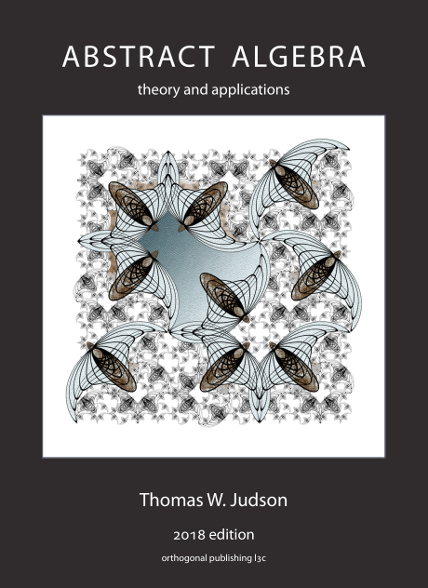Section 7.2 Maximal and Prime Ideals
In this particular section we are especially interested in certain ideals of commutative rings. These ideals give us special types of factor rings. More specifically, we would like to characterize those ideals \(I\) of a commutative ring \(R\) such that \(R/I\) is an integral domain or a field.
A proper ideal \(M\) of a ring \(R\) is a maximal ideal of \(R\) if the ideal \(M\) is not a proper subset of any ideal of \(R\) except \(R\) itself. That is, \(M\) is a maximal ideal if for any ideal \(I\) properly containing \(M\text{,}\) \(I = R\text{.}\) The following theorem completely characterizes maximal ideals for commutative rings in terms of their corresponding factor rings.
Theorem 7.13.
Let \(R\) be a commutative ring and \(M\) an ideal in \(R\text{.}\) Then \(M\) is a maximal ideal of \(R\) if and only if \(R/M\) is a field.
Proof.
Let \(M\) be a maximal ideal in \(R\text{.}\) If \(R\) is a commutative ring, then \(R/M\) must also be a commutative ring. Clearly, \(1 + M\) acts as an identity for \(R/M\text{.}\) We must also show that every nonzero element in \(R/M\) has an inverse. If \(a + M\) is a nonzero element in \(R/M\text{,}\) then \(a \notin M\text{.}\) Define \(I\) to be the set \(\{ ra + m : r \in R \text{ and } m \in M \}\text{.}\) We will show that \(I\) is an ideal in \(R\text{.}\) The set \(I\) is nonempty since \(0a+0=0\) is in \(I\text{.}\) If \(r_1 a + m_1\) and \(r_2 a + m_2\) are two elements in \(I\text{,}\) then
is in \(I\text{.}\) Also, for any \(r \in R\) it is true that \(rI \subset I\text{;}\) hence, \(I\) is closed under multiplication and satisfies the necessary conditions to be an ideal. Therefore, by Proposition 4.10 and the definition of an ideal, \(I\) is an ideal properly containing \(M\text{.}\) Since \(M\) is a maximal ideal, \(I=R\text{;}\) consequently, by the definition of \(I\) there must be an \(m\) in \(M\) and an element \(b\) in \(R\) such that \(1=ab+m\text{.}\) Therefore,
Conversely, suppose that \(M\) is an ideal and \(R/M\) is a field. Since \(R/M\) is a field, it must contain at least two elements: \(0 + M = M\) and \(1 + M\text{.}\) Hence, \(M\) is a proper ideal of \(R\text{.}\) Let \(I\) be any ideal properly containing \(M\text{.}\) We need to show that \(I = R\text{.}\) Choose \(a\) in \(I\) but not in \(M\text{.}\) Since \(a+ M\) is a nonzero element in a field, there exists an element \(b +M\) in \(R/M\) such that \((a+M)(b+M) = ab + M = 1+M\text{.}\) Consequently, there exists an element \(m \in M\) such that \(ab + m = 1\) and \(1\) is in \(I\text{.}\) Therefore, \(r1 =r \in I\) for all \(r \in R\text{.}\) Consequently, \(I = R\text{.}\)
Example 7.14.
Let \(p{\mathbb Z}\) be an ideal in \({\mathbb Z}\text{,}\) where \(p\) is prime. Then \(p{\mathbb Z}\) is a maximal ideal since \({\mathbb Z}/ p {\mathbb Z} \cong {\mathbb Z}_p\) is a field.
A proper ideal \(P\) in a commutative ring \(R\) is called a prime ideal if whenever \(ab \in P\text{,}\) then either \(a \in P\) or \(b \in P\text{.}\) 4
Example 7.15.
It is easy to check that the set \(P = \{ 0, 2, 4, 6, 8, 10 \}\) is an ideal in \({\mathbb Z}_{12}\text{.}\) This ideal is prime. In fact, it is a maximal ideal.
Proposition 7.16.
Let \(R\) be a commutative ring where \(1 \neq 0\text{.}\) Then \(P\) is a prime ideal in \(R\) if and only if \(R/P\) is an integral domain.
Proof.
First let us assume that \(P\) is an ideal in \(R\) and \(R/P\) is an integral domain. Suppose that \(ab \in P\text{.}\) If \(a + P\) and \(b + P\) are two elements of \(R/P\) such that \((a + P)(b + P) = 0 + P = P\text{,}\) then either \(a + P = P\) or \(b + P = P\text{.}\) This means that either \(a\) is in \(P\) or \(b\) is in \(P\text{,}\) which shows that \(P\) must be prime.
Conversely, suppose that \(P\) is prime and
Then \(ab \in P\text{.}\) If \(a \notin P\text{,}\) then \(b\) must be in \(P\) by the definition of a prime ideal; hence, \(b + P = 0 + P\) and \(R/P\) is an integral domain.
Example 7.17.
Every ideal in \({\mathbb Z}\) is of the form \(n {\mathbb Z}\text{.}\) The factor ring \({\mathbb Z} / n{\mathbb Z} \cong {\mathbb Z}_n\) is an integral domain only when \(n\) is prime. It is actually a field. Hence, the nonzero prime ideals in \({\mathbb Z}\) are the ideals \(p{\mathbb Z}\text{,}\) where \(p\) is prime. This example really justifies the use of the word “prime” in our definition of prime ideals.
Since every field is an integral domain, we have the following corollary.
Corollary 7.18.
Every maximal ideal in a commutative ring is also a prime ideal.
